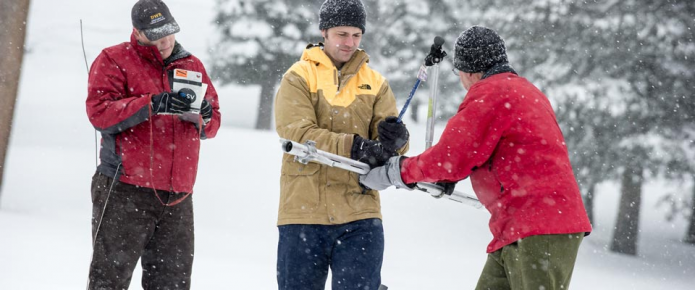
In this file photo from 2016 courtesy California Department of Water Resources a snow survey is done to measure the snowpack in the Sierras.
With above normal rains drenching much of California and snowpack levels on the rise, attention has turned to what this means for the state’s long-term drought. Media reports and opinion columns vary, with most of the focus aimed at the impacts to Northern California reservoirs and the State Water Project. Some reports declare the drought over as thirsty reservoirs up north begin to fill, certainly changing the tide of what has been ten mostly dry years. Other reports urge caution as weather patterns can quickly change, so to rush into an end-of-drought declaration is much too soon. Sustained rain and additional snow—with slow run-off into the spring—is needed to ensure the end of this prolonged drought is at hand, the more cautious in the field of water management argue. Again, most of the discussion in the media has focused on the northern part of the state.
But what about Southern California, much of which is served by a different basin: the Colorado River Basin?
Going into this wet season, Lake Mead—the reservoir that serves the Lower Colorado River Basin—has been at record low levels. For the last couple of years, water agencies in the Lower Basin states of Arizona, Nevada and California, have been on shortage watch. Meaning, when Lake Mead elevation falls below designated levels, a shortage declaration could be triggered and result in cutbacks. According to shortage sharing guidelines established in 2007, Nevada and Arizona would face the initial cuts to their annual Colorado River allocations. Should reservoir levels continue to fall, California could eventually have to reduce its use of Colorado as well. In fact, current negotiations on what has been called drought contingency planning could see California face cuts sooner than the 2007 guidelines.
So what impact are these storms having on the Lower Colorado River Basin and the management of the reservoirs? Could a shortage declaration be pushed back beyond 2018?
The answer is—likely no. River operations are a complicated process by the U.S. Bureau of Reclamation based on modeling and hydrology. To date—even with the storms—the Bureau’s projections indicate that unless there was a great deal more rain and snow, a shortage is still likely in 2018 and subsequent years. That’s not to say if weather patterns continue, projections couldn’t change. It just depends on how much rain and snow continue to fall through this storm season. Further, it would likely take more than one wet season to bring long-term changes to the depleted Colorado River system. Additional river management agreements such as the proposed drought contingency plan, could also help increase levels in Lake Mead, if adopted. However, measures like the drought contingency plan that could cause additional conservation should come with proper environmental reviews.
Secretary of the Interior Sally Jewell stated in a Jan. 18 press release that the storms, while benefitting Northern California, have brought no measurable improvements to the Colorado River system. Secretary Jewell’s comments were made in context of a Secretarial Order declaring that talks must continue on drought contingency planning and bi-national talks with Mexico.
So we are in a waiting game in terms of this long-term period of drought. That is true of any end-of-drought pronouncement for the State Water Project and Northern California and those parts of Southern California served by the State Water Project. And it is even more true for the Colorado River Basin. That said, let’s all keep our fingers crossed that the storms continue and that future years bring similar conditions.
While it may be a pun, the situation remains fluid.
As has been noted before, even with the storms we still must all do our part to conserve and protect our water resources. It falls on water agencies, cities, farmers, businesses and every individual to do their part throughout California. While there are a lot of unknowns right now about the long-term impacts of these storms, what is clear is that historically droughts come in cyclical patterns. Where one period of drought may end, others will eventually follow. What we do today will make a difference for the future.
